Mingjie Liu
Reinforcement Learning Optimization for Large-Scale Learning: An Efficient and User-Friendly Scaling Library
Jun 06, 2025Abstract:We introduce ROLL, an efficient, scalable, and user-friendly library designed for Reinforcement Learning Optimization for Large-scale Learning. ROLL caters to three primary user groups: tech pioneers aiming for cost-effective, fault-tolerant large-scale training, developers requiring flexible control over training workflows, and researchers seeking agile experimentation. ROLL is built upon several key modules to serve these user groups effectively. First, a single-controller architecture combined with an abstraction of the parallel worker simplifies the development of the training pipeline. Second, the parallel strategy and data transfer modules enable efficient and scalable training. Third, the rollout scheduler offers fine-grained management of each sample's lifecycle during the rollout stage. Fourth, the environment worker and reward worker support rapid and flexible experimentation with agentic RL algorithms and reward designs. Finally, AutoDeviceMapping allows users to assign resources to different models flexibly across various stages.
ProRL: Prolonged Reinforcement Learning Expands Reasoning Boundaries in Large Language Models
May 30, 2025Abstract:Recent advances in reasoning-centric language models have highlighted reinforcement learning (RL) as a promising method for aligning models with verifiable rewards. However, it remains contentious whether RL truly expands a model's reasoning capabilities or merely amplifies high-reward outputs already latent in the base model's distribution, and whether continually scaling up RL compute reliably leads to improved reasoning performance. In this work, we challenge prevailing assumptions by demonstrating that prolonged RL (ProRL) training can uncover novel reasoning strategies that are inaccessible to base models, even under extensive sampling. We introduce ProRL, a novel training methodology that incorporates KL divergence control, reference policy resetting, and a diverse suite of tasks. Our empirical analysis reveals that RL-trained models consistently outperform base models across a wide range of pass@k evaluations, including scenarios where base models fail entirely regardless of the number of attempts. We further show that reasoning boundary improvements correlates strongly with task competence of base model and training duration, suggesting that RL can explore and populate new regions of solution space over time. These findings offer new insights into the conditions under which RL meaningfully expands reasoning boundaries in language models and establish a foundation for future work on long-horizon RL for reasoning. We release model weights to support further research: https://huggingface.co/nvidia/Nemotron-Research-Reasoning-Qwen-1.5B
Open Materials Generation with Stochastic Interpolants
Feb 04, 2025Abstract:The discovery of new materials is essential for enabling technological advancements. Computational approaches for predicting novel materials must effectively learn the manifold of stable crystal structures within an infinite design space. We introduce Open Materials Generation (OMG), a unifying framework for the generative design and discovery of inorganic crystalline materials. OMG employs stochastic interpolants (SI) to bridge an arbitrary base distribution to the target distribution of inorganic crystals via a broad class of tunable stochastic processes, encompassing both diffusion models and flow matching as special cases. In this work, we adapt the SI framework by integrating an equivariant graph representation of crystal structures and extending it to account for periodic boundary conditions in unit cell representations. Additionally, we couple the SI flow over spatial coordinates and lattice vectors with discrete flow matching for atomic species. We benchmark OMG's performance on two tasks: Crystal Structure Prediction (CSP) for specified compositions, and 'de novo' generation (DNG) aimed at discovering stable, novel, and unique structures. In our ground-up implementation of OMG, we refine and extend both CSP and DNG metrics compared to previous works. OMG establishes a new state-of-the-art in generative modeling for materials discovery, outperforming purely flow-based and diffusion-based implementations. These results underscore the importance of designing flexible deep learning frameworks to accelerate progress in materials science.
Revisiting VerilogEval: Newer LLMs, In-Context Learning, and Specification-to-RTL Tasks
Aug 20, 2024Abstract:The application of large-language models (LLMs) to digital hardware code generation is an emerging field. Most LLMs are primarily trained on natural language and software code. Hardware code, such as Verilog, represents only a small portion of the training data and few hardware benchmarks exist. To address this gap, the open-source VerilogEval benchmark was released in 2023, providing a consistent evaluation framework for LLMs on code completion tasks. It was tested on state-of-the-art models at the time including GPT-4. However, VerilogEval and other Verilog generation benchmarks lack failure analysis and, in present form, are not conducive to exploring prompting techniques. Also, since VerilogEval's release, both commercial and open-source models have seen continued development. In this work, we evaluate new commercial and open-source models of varying sizes against an improved VerilogEval benchmark suite. We enhance VerilogEval's infrastructure and dataset by automatically classifying failures, introduce new prompts for supporting in-context learning (ICL) examples, and extend the supported tasks to specification-to-RTL translation. We find a measurable improvement in commercial state-of-the-art models, with GPT-4 Turbo achieving a 59% pass rate on spec-to-RTL tasks. We also study the performance of open-source and domain-specific models that have emerged, and demonstrate that models can benefit substantially from ICL. We find that recently-released Llama 3.1 405B achieves a pass rate of 58%, effectively matching that of GPT-4 Turbo, and that the much smaller domain-specific RTL-Coder 6.7B models achieve an impressive 37% pass rate. However, prompt engineering is key to achieving good pass rates, and varies widely with model and task. A benchmark infrastructure that allows for prompt engineering and failure analysis is key to continued model development and deployment.
Code Less, Align More: Efficient LLM Fine-tuning for Code Generation with Data Pruning
Jul 06, 2024



Abstract:Recent work targeting large language models (LLMs) for code generation demonstrated that increasing the amount of training data through synthetic code generation often leads to exceptional performance. In this paper we explore data pruning methods aimed at enhancing the efficiency of model training specifically for code LLMs. We present techniques that integrate various clustering and pruning metrics to selectively reduce training data without compromising the accuracy and functionality of the generated code. We observe significant redundancies in synthetic training data generation, where our experiments demonstrate that benchmark performance can be largely preserved by training on only 10% of the data. Moreover, we observe consistent improvements in benchmark results through moderate pruning of the training data. Our experiments show that these pruning strategies not only reduce the computational resources needed but also enhance the overall quality code generation.
Multi-dimension Transformer with Attention-based Filtering for Medical Image Segmentation
May 20, 2024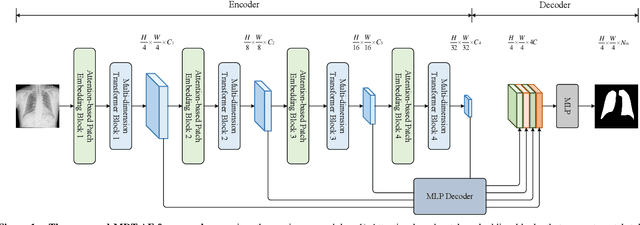
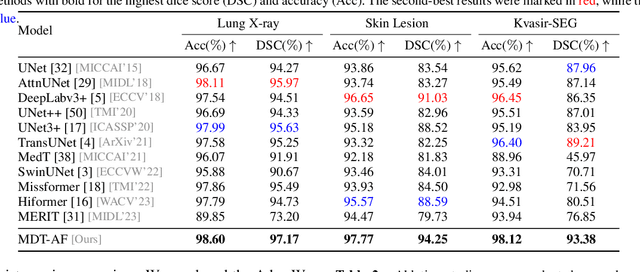
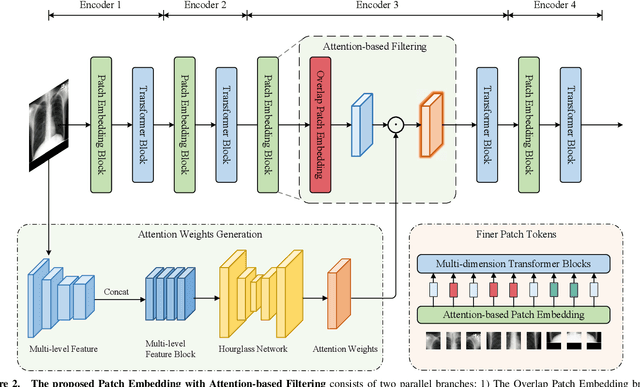
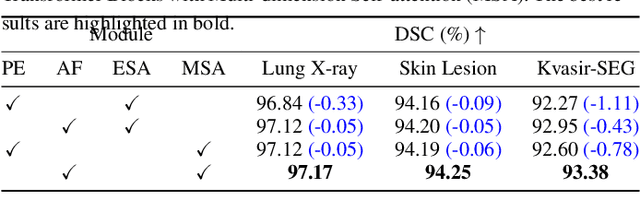
Abstract:The accurate segmentation of medical images is crucial for diagnosing and treating diseases. Recent studies demonstrate that vision transformer-based methods have significantly improved performance in medical image segmentation, primarily due to their superior ability to establish global relationships among features and adaptability to various inputs. However, these methods struggle with the low signal-to-noise ratio inherent to medical images. Additionally, the effective utilization of channel and spatial information, which are essential for medical image segmentation, is limited by the representation capacity of self-attention. To address these challenges, we propose a multi-dimension transformer with attention-based filtering (MDT-AF), which redesigns the patch embedding and self-attention mechanism for medical image segmentation. MDT-AF incorporates an attention-based feature filtering mechanism into the patch embedding blocks and employs a coarse-to-fine process to mitigate the impact of low signal-to-noise ratio. To better capture complex structures in medical images, MDT-AF extends the self-attention mechanism to incorporate spatial and channel dimensions, enriching feature representation. Moreover, we introduce an interaction mechanism to improve the feature aggregation between spatial and channel dimensions. Experimental results on three public medical image segmentation benchmarks show that MDT-AF achieves state-of-the-art (SOTA) performance.
Assessing Economic Viability: A Comparative Analysis of Total Cost of Ownership for Domain-Adapted Large Language Models versus State-of-the-art Counterparts in Chip Design Coding Assistance
Apr 12, 2024Abstract:This paper presents a comparative analysis of total cost of ownership (TCO) and performance between domain-adapted large language models (LLM) and state-of-the-art (SoTA) LLMs , with a particular emphasis on tasks related to coding assistance for chip design. We examine the TCO and performance metrics of a domain-adaptive LLM, ChipNeMo, against two leading LLMs, Claude 3 Opus and ChatGPT-4 Turbo, to assess their efficacy in chip design coding generation. Through a detailed evaluation of the accuracy of the model, training methodologies, and operational expenditures, this study aims to provide stakeholders with critical information to select the most economically viable and performance-efficient solutions for their specific needs. Our results underscore the benefits of employing domain-adapted models, such as ChipNeMo, that demonstrate improved performance at significantly reduced costs compared to their general-purpose counterparts. In particular, we reveal the potential of domain-adapted LLMs to decrease TCO by approximately 90%-95%, with the cost advantages becoming increasingly evident as the deployment scale expands. With expansion of deployment, the cost benefits of ChipNeMo become more pronounced, making domain-adaptive LLMs an attractive option for organizations with substantial coding needs supported by LLMs
ChipNeMo: Domain-Adapted LLMs for Chip Design
Nov 13, 2023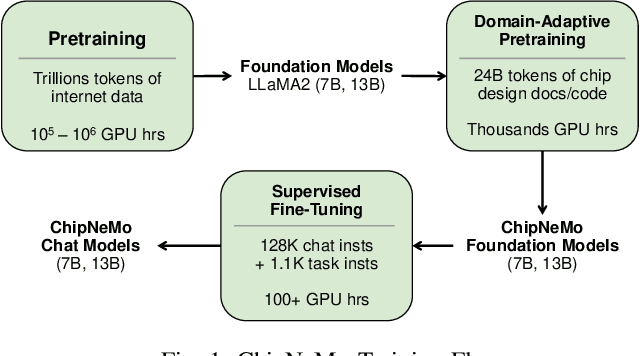
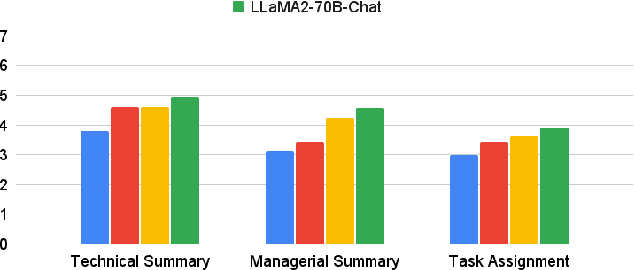
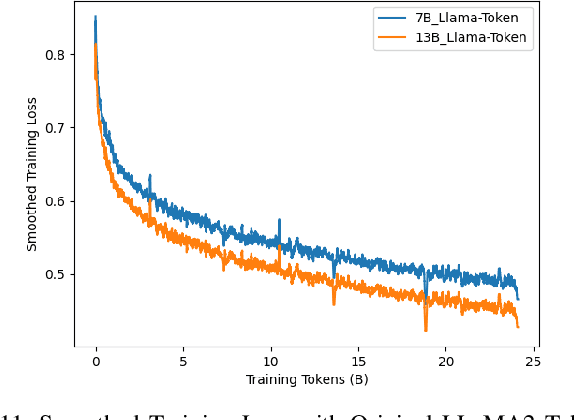
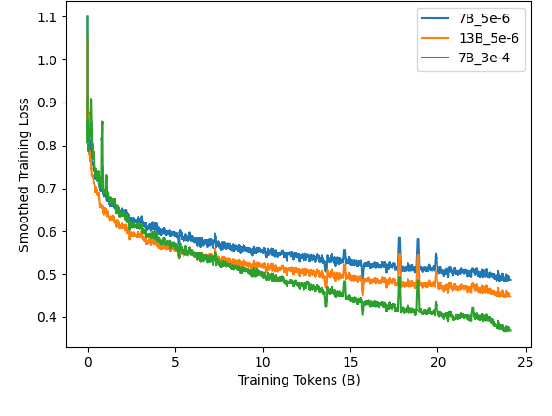
Abstract:ChipNeMo aims to explore the applications of large language models (LLMs) for industrial chip design. Instead of directly deploying off-the-shelf commercial or open-source LLMs, we instead adopt the following domain adaptation techniques: custom tokenizers, domain-adaptive continued pretraining, supervised fine-tuning (SFT) with domain-specific instructions, and domain-adapted retrieval models. We evaluate these methods on three selected LLM applications for chip design: an engineering assistant chatbot, EDA script generation, and bug summarization and analysis. Our results show that these domain adaptation techniques enable significant LLM performance improvements over general-purpose base models across the three evaluated applications, enabling up to 5x model size reduction with similar or better performance on a range of design tasks. Our findings also indicate that there's still room for improvement between our current results and ideal outcomes. We believe that further investigation of domain-adapted LLM approaches will help close this gap in the future.
VerilogEval: Evaluating Large Language Models for Verilog Code Generation
Sep 14, 2023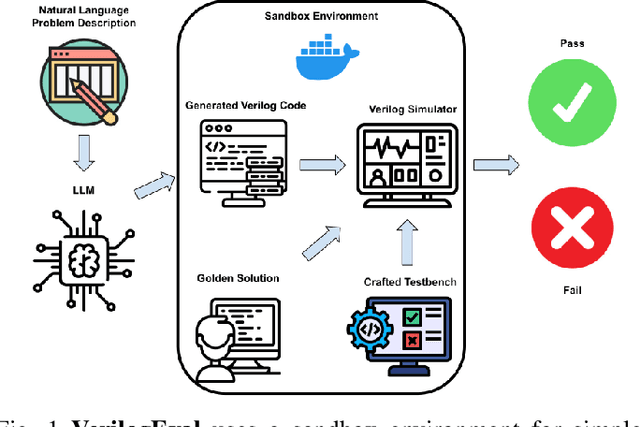
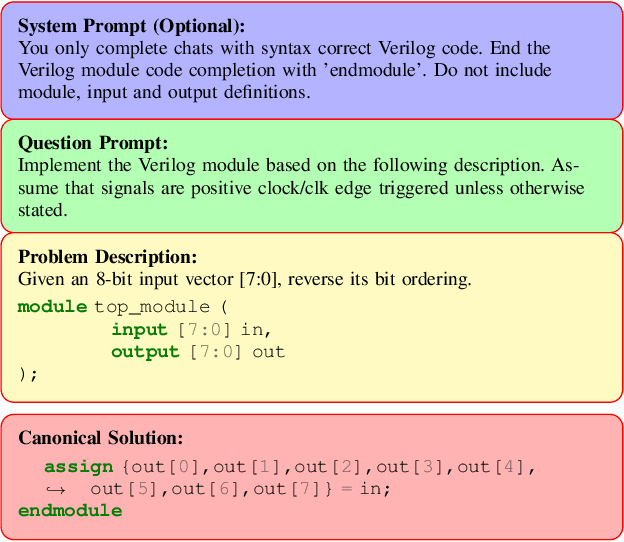
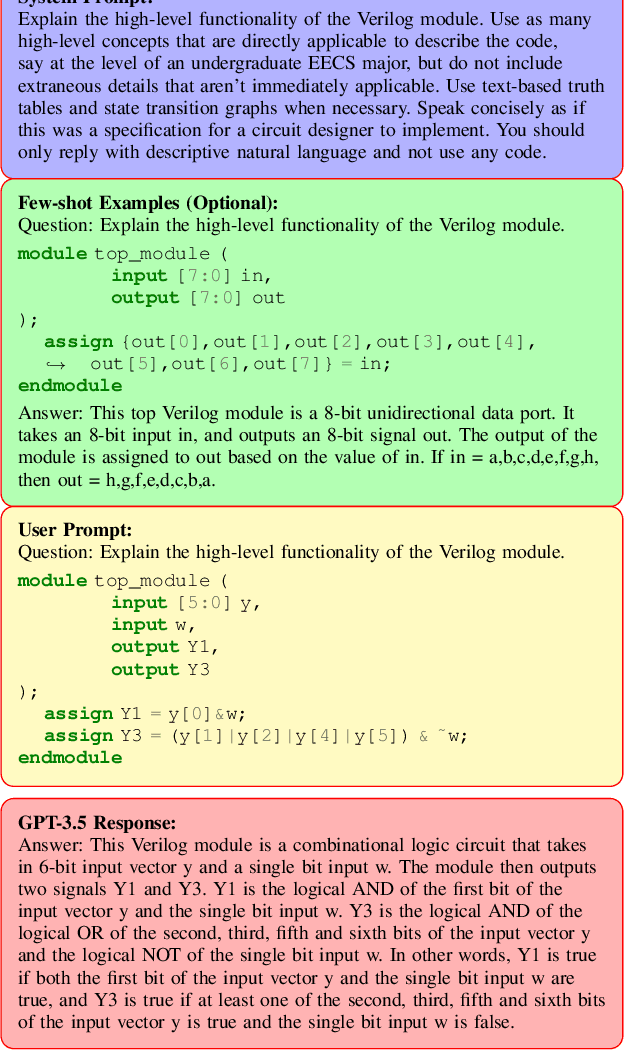
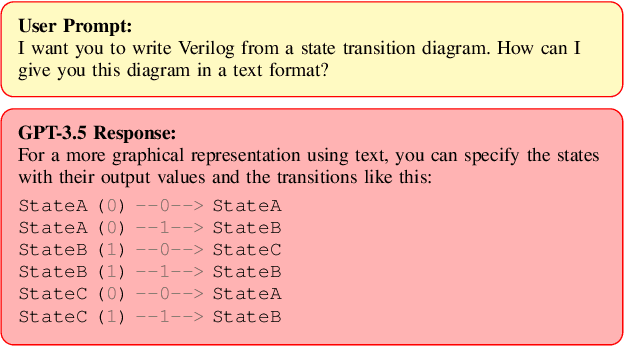
Abstract:The increasing popularity of large language models (LLMs) has paved the way for their application in diverse domains. This paper proposes a benchmarking framework tailored specifically for evaluating LLM performance in the context of Verilog code generation for hardware design and verification. We present a comprehensive evaluation dataset consisting of 156 problems from the Verilog instructional website HDLBits. The evaluation set consists of a diverse set of Verilog code generation tasks, ranging from simple combinational circuits to complex finite state machines. The Verilog code completions can be automatically tested for functional correctness by comparing the transient simulation outputs of the generated design with a golden solution. We also demonstrate that the Verilog code generation capability of pretrained language models could be improved with supervised fine-tuning by bootstrapping with LLM generated synthetic problem-code pairs.
An Adversarial Active Sampling-based Data Augmentation Framework for Manufacturable Chip Design
Oct 27, 2022Abstract:Lithography modeling is a crucial problem in chip design to ensure a chip design mask is manufacturable. It requires rigorous simulations of optical and chemical models that are computationally expensive. Recent developments in machine learning have provided alternative solutions in replacing the time-consuming lithography simulations with deep neural networks. However, the considerable accuracy drop still impedes its industrial adoption. Most importantly, the quality and quantity of the training dataset directly affect the model performance. To tackle this problem, we propose a litho-aware data augmentation (LADA) framework to resolve the dilemma of limited data and improve the machine learning model performance. First, we pretrain the neural networks for lithography modeling and a gradient-friendly StyleGAN2 generator. We then perform adversarial active sampling to generate informative and synthetic in-distribution mask designs. These synthetic mask images will augment the original limited training dataset used to finetune the lithography model for improved performance. Experimental results demonstrate that LADA can successfully exploits the neural network capacity by narrowing down the performance gap between the training and testing data instances.
 Add to Chrome
Add to Chrome Add to Firefox
Add to Firefox Add to Edge
Add to Edge